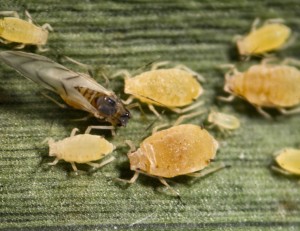By Steve Byrns, Texas A&M AgriLife Communications
September 12, 2014
Floyd County find is region’s first

Sugarcane aphid nymphs and an adult on a grain sorghum leaf. (Texas A&M AgriLife Extension Service photo by Dr. Pat Porter)
FLOYDADA — They’re hundreds of miles from the nearest sugarcane fields, nevertheless sugarcane aphids have now been positively identified in significant numbers on grain sorghum in Floyd County, said a Texas A&M AgriLife Extension Service entomologist.
The confirmation near the Briscoe and Swisher county lines is the first positive identification of a sizable population on the Southern High Plains, said Dr. Charles Allen, AgriLife Extension’s state integrated pest management coordinator at San Angelo.
“Dr. Pat Porter, AgriLife Extension agronomist at Lubbock, documented the find on Sept. 9.” Allen said.
“Blayne Reed, AgriLife Extension integrated pest management agent for Hale and Swisher counties, brought in a bag of sugarcane aphids, a fairly large colony collected from grain sorghum leaves on Sept. 9,” Porter said. “These aphids were collected by Clay Golden, an independent crop consultant serving the area. The aphids were in the same area where Blayne found individual adult sugarcane aphids on grain sorghum panicles 16 days ago.
“This timetable would be about right as we are told it takes 10 days to two weeks for sizable colonies to establish.”
Allen said the pest isn’t new to the U.S., but its expanding range and taste for grain sorghum and forage sorghums are. Sugarcane aphid reproduce very quickly and when large populations develop and go untreated yield losses and harvest problems can develop, he said.
“Aphid feeding removes nutrients and causes leaf damage,” Allen said. “Aphid numbers can become so high that their waste called honeydew, can actually ‘gum up the works’ in combines, thus interfering with harvesting.”
The pest moved from the Lower Rio Grande Valley into the blacklands and northern blacklands earlier this summer and has also been confirmed in the Concho Valley in West Central Texas, Allen said.
The sugarcane aphid, Melanaphis sacchari, was first found in Texas last summer, but has been in Florida since 1977 and Louisiana since 1999, Allen said.
“Growers need to keep a close watch on their grain sorghum up to the time of harvest,” Allen said. “When about 40 percent of the plants are infested with 100 or more aphids per leaf, it’s time to spray.” He said the tiny tan to cream colored sugarcane aphids initially colonize on the undersides of leaves near the bottom of the plants, then move up as their populations increase.
“A Section 18 emergency label was granted earlier this year by the U.S. Environmental Protection Agency for the pesticide Transform, the only labeled, effective control on this particular aphid,” Allen said. “The waiver allows for application rates from 0.75 to 1.5 ounces per acre. And only two applications are allowed during a single growing season, so timing and thorough coverage are crucial for best results. Also, remember that this pesticide requires a 14-day interval between application and harvest.”
For more information, contact Allen at 325-653-4576, ctallen@ag.tamu.edu or Porter at 806-746-6101 p-porter@tamu.edu .